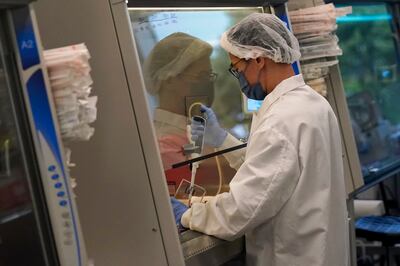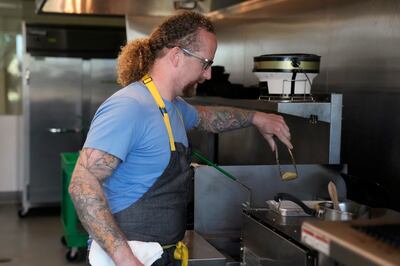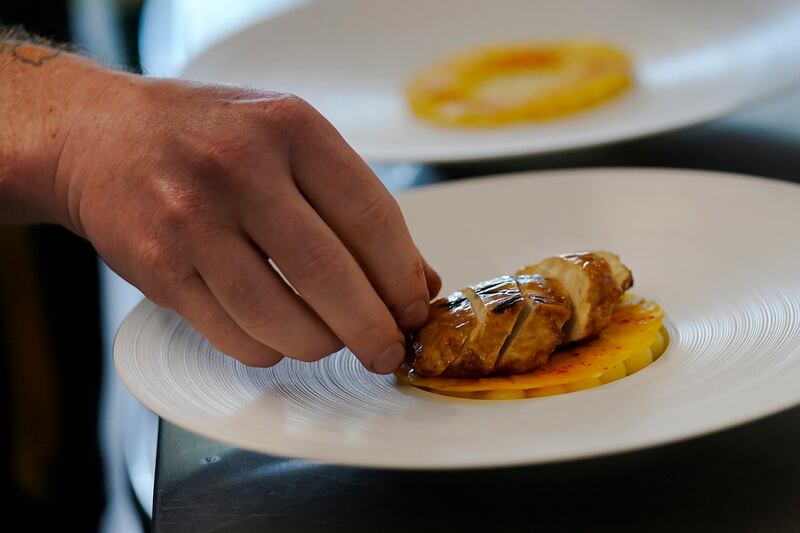The US government on Wednesday granted permission for California companies Upside Foods and Good Meat to sell chicken made from animal cells.
This new type of meat, say proponents, is better both for animals and the environment because land does not need to be cleared for grazing or growing feed, and livestock does not need to be raised and killed.
What is meat grown from animal cells?
The meat is grown from the cells of animals in steel tanks. Though it's known in the industry as cultivated meat, it's sometimes called cultured meat, lab-grown meat or cell-based meat.
There are more than 150 companies around the world trying to develop these food products. They're working on a variety of meats, including chicken, beef and lamb.
How is it made?

The cells can come from a fertilised egg, a special bank of stored cells or tissue initially taken from a living animal. They are then mixed with a broth of nutrients, which trigger the cells to grow and divide, and turn into skeletal muscle, fat and connective tissues. Then the cells are removed from the tanks and shaped into products such as nuggets and hamburgers.
While items made with ground meat are easiest to shape, some companies are working on products with more structure, such as chicken breasts and steaks. Those need a scaffold, or structure for the cells to grow on, which can be vegetable-based or made of animal products like collagen.
Is it really meat?
Experts say it's real meat created in a different way. It's not the same as plant-based products such as Impossible burgers, which do not contain animal cells. Some versions of cultivated meat – including Good Meat chicken products – do contain a small amount of vegetable proteins. Upside Foods officials say their meat does not.
What does it taste like?
Health reporter JoNel Aleccia, who taste-tested the “chicken” made by both California companies, reports: When I told friends and family I was reporting on the first chicken meat grown from animal cells, their first comment was "eww". Their second comment was: "How does it taste?"
The short answer: It tastes like chicken.
The longer answer, which folds in the “eww” response, is more nuanced. Yes, it's strange to think of eating a new kind of meat – chicken that doesn't come from a chicken, meat that will be sold as “cell-cultivated” chicken.
But it's also interesting (and exciting) to taste-test the first offerings of a new era in meat production, which aims to eliminate harm to billions of animals slaughtered for food – and to dramatically reduce the environmental effects of grazing, growing feed for those animals and dealing with their animal waste.
I'm a lifelong meat eater. I'm also a victim of the “meat paradox,” a term scientists use to describe the psychological conflict that occurs in people who like to eat meat but don't like to contemplate the animals that died providing it.
As someone who has reported on food-borne illness outbreaks and slaughterhouse safety, I'm keenly aware that the chicken on my dinner plate probably suffered to get there. And that fact makes me uneasy if I dwell on it too much.
So I was open to trying a different kind of meat – and also curious to see if it would taste like the real thing.
I've tried plant-based options like the Beyond Meat sausage and the Impossible Burger and liked them, even though I didn't think they were perfect substitutes.
What about the artificiality of it all? It didn't bother me that this new cultivated meat is made from cells that grow to epic proportions in big steel vats, only to be shaped and formed – “extruded” is the somewhat unfortunate verb that came to mind – into familiar cutlets, fillets and nuggets that would look right at home on the dinner table.

But as with all food, in the end it would come down to taste. And in this case, to the larger question behind it: Is this new material in fact chicken, or is it an impostor?
In January, I travelled to the Upside Foods manufacturing plant in Emeryville, California. There, chef Jess Weaver sauteed a cultivated chicken breast in a white wine butter sauce with tomatoes, capers and green onions. The aroma was enticing, just like any fillet cooked in butter would be. And the taste was light and delicate with a tender texture, just like any chicken breast I’d make at home – if, that is, I were a chef trained at the Culinary Institute of America.
This month, I visited the Alameda, California, plant where Good Meat is poised to begin production of its chicken products. Chef Zach Tyndall was ready with a smoked chicken salad with mayonnaise, golden raisins and walnuts. He followed it with a chicken “thigh” dish – darker meat served on a bed of potato puree with a mushroom-vegetable demi-glace, golden beets and tiny purple cauliflower florets.
The taste was richer than a chicken breast, more like the dark meat of a thigh. And the texture was both tender and chewy, like a well-cooked chicken thigh should be.
That, says Tyndall, is the whole point. “It needs to be as lifelike as possible for it to catch on,” he said.
While “lifelike” is an interesting word, from my side of the fork I think this will catch on. There are still huge hurdles – how to scale up manufacturing and pare back costs, experts say, and the lingering question of whether chicken without the bird is, in fact, chicken – but if you're basing it on authentic taste, I'll leave you with this: Please pass the “chicken”.
Where can you get it?
At this point, you can’t buy these meats at the grocery store – they will initially be rolled out at American restaurants followed by retailers in the next two to five years, and will be on supermarket shelves within seven to 10 years, said Sebastian Bohn, a project manager specialising in cell-based food for CRB, a Missouri firm that designs and builds facilities for pharmaceutical, biotech and food companies.
However, said Bruce Friedrich, president of the Good Food Institute, until this meat costs and tastes the same as traditional meat, “it's going to stay niche”.
Some people also find the idea of meat from cells strange. A recent poll conducted by the Associated Press and the Norc Center for Public Affairs Research found half of US adults said that they are unlikely to try it as they didn't think it would be safe.
A World Health Organisation report on the food safety aspects of cell-based food noted several potential issues, such as microbial contamination at various points in the process, biological residues and by-products and scaffolding that some people might be allergic to. But experts noted that conventional meat also carries risks, such as bacterial contamination before and during the slaughtering and packaging process.






